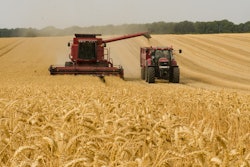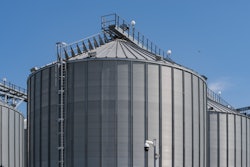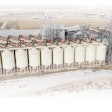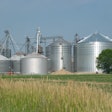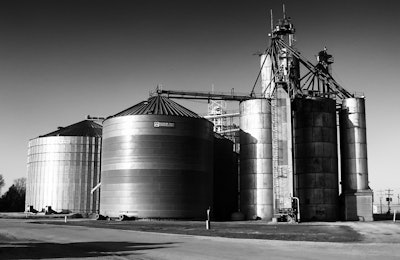
Steven Kilger, the host of theFeed & Grain Podcast, speaks withTanner Ehmke, the lead economist for grain and oil seeds atCoBank. Together they discuss Ehmke's report titled "Rising Cost of Grain Storage Will Force Elevators to Lower Bids, Widen Basis."
Ehmke解释当前的经济环境中,characterized by inflation, rising costs of operation, and increasing interest rates, is creating a challenging situation for grain elevators.
With commodity prices still historically high and interest rates rising, the cost of borrowing against commodities for elevators is expected to reach record levels. Other factors such as transportation costs, labor scarcity and increasing expenses for electricity, fuel and insurance are further adding to the financial burden.
Steven Kilger: Hi everyone, welcome to theFeed & Grain Podcastand thank you for listening. My name is Steven Kilger, managing editor of Feed & Grain and your host today. We have a great show for you today. Tanner Ehmke, lead economist for grain and oil seeds at CoBank, is my guest. We're talking about a report Ehmke wrote for CoBank called "Rising Cost of Grain Storage Will Force Elevators to Lower Bids, Widen Basis."
It's a fascinating report and a timely discussion on the grain market that we're currently facing. But before we get into that, if you're listening to this podcast within a podcast app, please consider subscribing and leaving a review if you're able to. It really helps us out and lets us know that you're listening. If you can't do that, though, you will find the Feed & Grain Podcast in every singleIndustry Watch newsletter,and we'll keep you updated on the newest episodes that are coming out. Thank you so much for listening to my conversation with Tanner.
Hi Tanner. Thanks so much for talking to us today. Great to have you here. Can you tell me more about yourself and what you do at CoBank?
Tanner Ehmke:I am the lead economist for grains and oil seeds at CoBank in Denver, Colorado, and I focus on grain and oil seed markets.
Kilger:I have you here because CoBank released this really interesting report written by you called "Rising Cost of Grain Storage Will Force Elevators to Lower Bids, Widen Basis." It's interesting how all these economic things are merging together to make this like a perfect storm of this carry price increase. How have rising interest rates impacted the cost of carrying grain and oilseed inventories for grain merchandisers over the past year?
Ehmke:I think you characterize that exactly what it is, Steven. It's a perfect storm. We've got rising costs of everything in this inflationary environment. Those of us in agriculture have not escaped that. The Federal Reserve has responded by raising interest rates at the fastest pace in decades, so here we are with higher operating costs and rising interest rates at a time when grain elevators are borrowing against commodities that are also still historically high.
现在美国农业部预测,玉米、小麦和soybean prices are going to be coming down in the '23-'24 crop year, but they're still high historically compared to the years and decades past. When you have interest rates at the highest, they've been in several years, and you have commodity prices that are still historically high, well, it's going to cost you a lot more to borrow on those commodities.
We're forecasting that the cost of storing and owning commodities is going to be the highest on record because of this confluence of factors.
As for interest rates, in our paper, we estimate interest rates are going to be about 7 3/4% percent for most grain elevators. We just use USDA's forecasts on wheat and soybeans, their average marketing year prices that they recently posted. You do the math and have the estimated financial cost of carrying for the forthcoming crop year at the highest on record.
Based on the Federal Reserve's latest messaging sounds like we may not be done yet. They just met here recently, and they put their interest rate increases on pause for the time being, but they made it very clear there may be more increases yet to come. That is going to add further upward pressure on the cost of ownership of anything. For corn, wheat and soybean prices where they're at, it's going to add further burden of ownership.
Kilger: Throughout most of my adult life now, we've been dealing with really low historical interest rates from the Fed. This raise, these high-interest costs, are something a lot of us have never really dealt with.
Ehmke: That's exactly right. It's been the talk of the industry. There are a lot of grain traders out there and a lot of grain elevators that have not experienced this type of environment. It's going to be a learning curve for a lot of people.
Kilger:But it's not just interest rates. As you said, the cost of everything is rising, including operation costs, transportation, fuel, electricity and labor, if you can find labor at all. How do all these other things now that are also affecting the financial burden of carrying grain for elevators as well?
Ehmke:You're exactly right, Steven. The costs of everything have gone up. Transportation costs have been problematic for grain elevators. They don't sometimes know how to set a basis because they don't know if they can get train cars.
You have labor extremely tight. It's always been tight in rural America. Now it's a nationwide problem with labor being so scarce and wages going up. Then electricity and fuel, those prices have gone up, although prices of some of these commodities like fuel or expected come down from last year's peaks, are still historically high.
You add up all of these rising costs. There's not a lot that elevators have to control on cost here. I should point out there's one more very important cost, and that is insurance. And my colleague, Ken Zuckerberg, here at CoBank, has just recently come out with a paper onthe rising cost of insurance for grain merchandisers.That's just adding phenomenal burden on grain elevators. There's just very little wiggle room here to reduce these costs.
What does a grain elevator do? Well, if you can't cut these costs. For instance, you cannot have insurance, you cannot have transportation, and maybe you can trim some labor in some areas. But for a lot of these costs, they are just what they are. The way you manage it is you're going to lower your local bid in order to pay for it. You're going to have to widen your basis to afford this higher cost burden.
Kilger: Lowering any of those costs usually inflicts other costs. You can lower your labor costs, but it usually involves investing in automation. So, it's not a quick fix, and it also takes capital to do.
Ehmke:There's a lot of conversations out there about automation. Again, these are longer-term issues. It takes money to invest those capital expenditures. But you're right. These are issues that are longer term. They all kind of coalesced this year, all at once, in this inflationary environment. With the rising cost of everything, rising interest rates, plus high commodity prices -- all this kind of gets everybody all at once.
Kilger: It seems like everyone has different things that they want from these very different motivations. So, you have grain elevators, and you obviously want grain out as quickly as possible, and end users would prefer not to buy until they absolutely need it. So, their prices don't go up. Then there are producers in the mix, too, who want the best price for their crop and don't want to worry about storage so much. Can you tell me kind of how all the stakeholders have different views of what they want? And how is this kind of impacting their strategies and the strategies of grain elevators?
Ehmke: Sure, well, I think you characterize it very well. Commodities now are kind of like a hot potato. You want to pass it on as fast as you can because you're trying to lower your storage costs, which can be so high in this environment.
从电梯的角度来看,你想啊ut the door as fast as you can. From the farmer's standpoint, you don't want to pay storage on it either. You would be motivated to move it as fast as you can. If you're the end user, you want to delay ownership for as long as possible because they want to keep their storage costs as low as possible as well. They don't want to have to be sitting on high-priced inventory. The more they borrow against it, thereby reducing how much they have in their working capital which can take away from other business operations when you got capital tied up in your inventory.
It's the hot potato -- people are going to want to move it away as fast as possible or delay receiving it for as long as possible. You've got some competing motivations here throughout the supply chain, and it's ultimately probably going to be the elevator when they want to pass it on to the end user, the end user is going to say no, I don't want right now you're going to have to sit on it. Therefore, the elevator is going to be stuck holding for a longer period of time -- longer than they would probably normally want to. It's going to end up coming out of their pocket. What do they do? They widen their basis. Unfortunately, then, that'll be the farmer that usually that ends up paying.
Kilger:In your report, you talk about inverted markets for futures being so high right now. Can you explain to me what an inverted market is and how it's affecting all of this?
Ehmke:It's been a stressful time for a lot of grain traders out there. Basically, the future price of grain in an inverted market is lower than today's spot price. That's not how the future markets are normally functioning. If you're going to store commodities, you want those future prices to be higher to at least cover your cost of operation or at least cover your financial burden, which is mostly in the interest expense, but that's not happening right now. That's been the case here for the last crop year, at any rate.
Because of the tight stock situation with old crops, the market is trying to incentivize to deliver commodities to the market as fast as possible. We talked about the hot potato phenomenon, trying to move it as fast down the supply chain as possible. Well, the inverted market with lower prices in the future adds further pressure on the supply chain to do that. If you're holding grain for any amount of time, while you're getting double penalized, your costs are elevated, or all the things that we just talked about. Then at the same time, you have this inversion, which is adding a further penalty to anyone holding grain. So, it just adds more burden still to grain traders and elevators that are in the business of storing commodities.
Kilger:Your report specifically focuses on co-op grain elevators because they're in a bit of a different situation. Private companies can always just not take grain, but with a co-op, you have members whose job is to store their grain.
Ehmke:Exactly, exactly. It's not like you're going to call up your farmer members and say, "we're not taking your grain this year." That's not how a co-op works. They're obligated to post a bid. Whereas if you're a private grain trader, maybe you don't have to. If you don't want to, you have that freedom. The co-op has no such freedom. They are obligated to post a bid for their members.
Kilger:How do you think this is going to affect their local bids on their basis for those grain co-ops? What are they going to have to do in this kind of market?
Ehmke:Market-wide, everyone is going to be faced with the question of how low to post the bid. Everyone is dealing with the same stresses to varying degrees. Now not all markets are the same. No two markets are identical. It's got to be different from one co-op to the next, depending upon their debt structure, depending upon their local market and grain availability and what have you and what local demand been looking like. But the pressures are the same.
There is going to be an incentive for all cooperative grain elevators to widen their basis. Now, to which degree, as I said, that's going to depend from one co-op to another, depending upon a whole number of factors. But the pressures are the same there. It's going to be the same for every co-op. They widen their basis.
Kilger:Thank you so much for talking to me. Those are all the questions I have. Did I miss anything? Is there anything else you'd like to talk about?
Ehmke:I think I would add, Steven, that when co-ops are sharing this stressful market, fundamental of the rising cost of operation and what have you and everybody are facing the same challenges. It's important to be honest and upfront with your members and say, "This is the situation and we are going to be seeing a widened basis environment very likely in the area." I would recommend they communicate this early and often with their co-opers.
Kilger:Great advice all around. Best just to be open and honest with anyone you're taking in grain from.
Ehmke:Absolutely. You don't want to have any surprises.
Kilger:Exactly. The fewer surprises you can have in an already stressful time is for the best.
Ehmke: Exactly.
Kilger:Thank you so much for talking to me and our listeners today.
Ehmke:Glad to be here. Thanks for having me, Steven.
Kilger:And for everyone listening out there. Thank you so much, and we'll talk to you next time.

.jpg?auto=format%2Ccompress&crop=faces&fit=crop&h=48&q=70&w=48)




